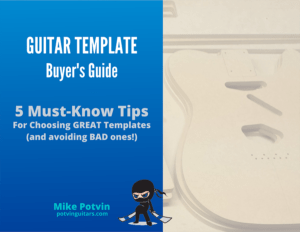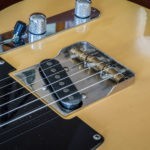A Fender-style neck pocket such as those found on a Telecaster or Stratocaster is typically 5/8″ deep. Read on to find out why, and what to do for different types of bridges and also non-bolt-on neck types.
The not-so-short answer
There are a few factors that determine how deep to route a neck pocket. The two most important are neck attachment type and the style of bridge you’re using. Instead of just memorizing the Tele neck pocket dimensions, let’s look at these factors more closely and learn how to calculate the neck pocket depth for any guitar.
Neck pockets for bolt-on necks
Bolt-on necks tend to be found on Fender-style Guitars. What does “Fender-style” mean? It’s essentially shorthand for a guitar that has a bolt-on neck and a bridge that holds the strings close to the body and therefore does not require a neck angle. A Fender Telecaster is an example of what we’re talking about here. Before we learn to calculate the neck pocket depth, first we need to talk a bit about the heel area on a bolt-on neck.
Anatomy of a neck
Although there are one-piece necks that don’t have a separate fretboard glued on, we’re going to restrict ourselves to talking about necks that have a separate fretboard because it makes it easier to follow the concepts.
First, we need to understand that a neck consists of two parts: the neck shaft and the fretboard. For a Fender-style neck, the neck shaft is typically 3/4″ (~19mm) thick. The fretboard is usually radiused so it’s thinner on the outside edges, but at its thickest point it’s 1/4″ (~6.4mm) thick. So to sum that up, neck-shaft (3/4″) + fretboard (1/4″) = 1.0″ (~25.4mm) overall neck heel thickness.
Neck pocket depth calculation
At last! Now we get to the math. Let’s start with this golden “rule”: the top of the fretboard needs to be 3/8″ (~9.5mm) above the top of the body. That works out to a comfortable amount of wiggle room for string height adjustment with a low-profile bridge. In the wishy-washy world of guitar building, sometimes there are no rules, and other times there are! Think of this as one instance where history has shown that this “rule” is pretty solid.
So, we have a 1.0″ thick neck. If we routed a 1.0″ deep neck pocket, the top of the fretboard would be flush with the top of the guitar. We need to raise that fretboard up 3/8″, so we reduce our too-deep 1.0″ neck pocket by 3/8″ and end up with a pocket depth of 5/8″. For the math-impaired: 1.0″ (or 8/8″) – 3/8″ = 5/8″. To translate that for the engineering inclined: 1.0″ – 0.375″ = 0.625″.
Remember the “rule” that having the fretboard 3/8″ above the top of the body makes for good string height? Well, it also works in our favor when it comes to pickguards as well. If the fretboard is 3/8″ above the body, and the fretboard is 1/4″ (or 2/8″) thick, that means the bottom of the fretboard is 1/8″ above the top of the body. That comes in really handy if you happen to have a fretboard that extends out past the end of the neck-shaft because 1/8″ is a comfortable amount of space to slide a pickguard under.
If you need a neck pocket template, I can help with that.
So that’s the “straight-forward” world of how to calculate neck pocket depth for a Fender-style guitar. Now, let’s shake things up a bit.
Does anything change with different bridge styles?
Yes. Yes it does. Bridges generally come in two styles:
- Bridges that do not require a neck angle. A Fender Telecaster is an example of a guitar using a low-profile bridge that does not require a neck angle. It doesn’t require a neck angle because the string height at the bridge is quite low (close to the body). This type of guitar will have a neck pocket that is flat (no angle).
- Bridges that do require a neck angle. A Gibson Les Paul is an example of a guitar using a bridge that requires a neck angle. It requires a neck angle because the string height at the bridge is quite far from the top of the body. This type of guitar may have a neck pocket that is angled (deeper at the end farthest from the bridge). The neck angle can also be created on the heel of the neck, but for this conversation, we’ll assume it’s in the neck pocket.
So how does the type of bridge affect the neck pocket depth? We’ve already covered the low-profile bridge scenario, so let’s look at the “tall” bridge option, often referred to as a “Gibson-style” bridge.
In the case of a low-profile bridge, let’s say the string height at the bridge is somewhere in the area of 3/8″ (~9.5mm) to 7/16″ (~11mm). The exact number is not important, just the fact that it’s low compared to the skyscraper ~3/4″ (~19mm) of a typical Gibson-style Tune-o-matic bridge.
We need to raise the string height in the bridge area about 3/8″ higher than where it is with a low profile bridge (3/8″ + 3/8″ = 6/8″ or 3/4″). We can’t just make the neck pocket shallower to raise the neck though. Our standard 5/8″ deep neck pocket minus the 3/8″ we need would leave us with a pocket depth of 1/4″ and that won’t work! So, instead, we angle the neck just enough to raise the strings to our desired height. One way to achieve this is an angled neck pocket
The magical angled neck pocket
Angled neck pockets aren’t that complicated. The end of the pocket closest to the bridge is one depth, and the end closest to the headstock is a little deeper. How much deeper depends on the angle you need, and that’s a topic to cover on another day! Let’s just say the shallow end is still 5/8″ for all the reasons we’ve already discussed, and the deep end is a little deeper.
How deep do you route the neck pocket for a set-neck guitar?
I’ve got good news for you. Now that we’ve done all the heavy theory for bolt-on necks, discussing set-neck guitars just got a whole lot easier! You’ve learned many of the elements of neck/pocket design. Let’s learn a few more.
Where bolt-on necks tend to have a total heel thickness of 1.0″, many set-neck heels are thicker. That’s not always the case, but it often is. Set-necks still have the same 1/4″ fretboard though, so that means the neck shaft is thicker than 3/4″. How much thicker? There’s no set rule. Not even a rule of thumb! But it doesn’t matter. All you have to remember is one simple thing: all the theory about how high the fretboard is above the top of the body for a bolt-on neck is still true for a set-neck. Read that again. In other words, the “official” formula for neck pocket depth on a set-neck is: deep enough to get the top of the fretboard 3/8″ above the top of the body. Done. Well, sort of “done”…
Exceptions. There had to be exceptions!
There are a few instances where all this wonderful theory falls down. Bridges that are recessed (sunk) into the guitar body; carved top guitars where the fretboard sits ON the guitar’s top; odd bridge types, and so on. All of these can alter the neck/pocket geometry. Just be aware of these cases and use the design concepts you’ve learned to get the string height at the bridge where you know it needs to be.
Over to you
We’ve covered a fair bit of theory here. Take some time to digest it all, go slow, and measure twice (three times even!). Now that you’ve got these design concepts in your bag of tricks, you’ll know how to tackle any build much better than if you had just memorized “neck pockets are 5/8″ deep”. Let me know how it goes.

Mike Potvin
Chief Sawdust Officer
Keep reading:
Don’t Take Chances
Learn the secrets to choosing great templates
Yes! Alert me when new Guitar Templates & Jigs are released





Awesome wording and explanation. Question – when measuring the thickness of the neck, do I include the frets? IE: Measure at the heal of the neck from the bottom to the top of the highest fret? I’d imagine it does. Thank you!
Thanks Andy. Generally speaking, you don’t include the height of the frets when referring to neck thickness, at least during the woodworking phase of the build.
Very helpful Mike! and very well explained.
Glenn
Thanks Glenn!
Hello Mike – thank you for the clearly worded article. Regarding the 3/8ths in over the body spec for the fretboard/neck, is that measurement taken from the sides (and if so does it include the top of the fretwires or just the actual board surface itself)? Or is it taken from the center just above the trussrod axis? Hopefully this makes sense and thanks in advance for your input.
Ron
Hi Ron – to recap, the completed neck is 1″ thick (1/4″ at the thickest part of a radiused fretboard + 3/4″ shaft). The fret height is not involved here, nor is the radiused fretboards’ thickness at its outer (thinnest) edges. The 3/8″ measurement is from the thickest (middle) part of the radiused fretboard to the top of the body. It’s best to imagine that you have a fretboard overhang where the fretboard extends beyond the end of the neck shaft. You need enough room (1/8″) to slip a pickguard under that overhang.
Correction: (for solid body guitar with bolt-on neck)
1. The height of the frets is, in fact, very important. It is the level where all your string height adjustments are taken from. The height of the fretboard is not important.
2. There is nothing magic about the 5/8 neck pocket depth. It’s just an old convention that derived from the early development of the bolt-on neck concept. Take measurements; don’t blindly copy old numbers. Assume that your guitar is unique, and check everything.
If the bridge saddles will not go low enough to get the strings down to the desired height above the 12th fret (which is where we usually measure to set the string heights) then the bridge is too high, or the neck pocket is too deep. Either way, something is wrong and you will have to find a lower bridge, or you will have to shim (or tilt) the neck. If everything is correct you should NEVER have to shim or tilt the neck. Don’t consider tilting of shimming until you understand what is wrong. You may have a big bow in your neck!
Fender had this problem with their early Jazzmasters. They carried their own 5/8 convention over from the Telecaster and the Strat only to find that they had to tilt the neck back because the bridge saddles wouldn’t go low enough. The current neck pocket depth of the Jazzmaster is close to 1/2 inch.
The depth of the neck pocket should be coordinated with the bridge design such that the lowest bridge saddle setting is capable of getting the strings down to the desired height setting above the 12th fret (or perhaps even a little lower). And all this is measured from the top of the frets; not from the fingerboard. The best you can do, however, is to argue that measuring to the fingerboard is a worst-case approach. But if you are in a marginal condition, measuring to the frets might make the difference that gets you out of trouble.
Hi Reggie, thanks for your comment.
1. I’m not sure if you read the post, but there’s no mention of the fret height being unimportant. I don’t mention fret height at all. If you follow my process, the difference in height between one type of fret wire and another will easily be accommodated by the saddle height adjustment of the bridge.
2. Again, no one is saying there’s anything “magical” about the depth of a neck pocket. It’s just math. I also don’t suggest that you “blindly copy” anything. In fact, in the second paragraph I say “Instead of just memorizing the Tele neck pocket dimensions, let’s look at these factors more closely and learn how to calculate the neck pocket depth for any guitar”. Perhaps you’re getting confused by my reference to “magical” neck angles, by which I mean they solve an issue (taller Gibson-style bridges) like “magic”.
I think we’re saying the same thing 🙂
Hi,
I read some time ago that if the string tension is high resulting in not so easy playability, you can sand down the neck pocket and it will loosen up the string tension. I think it was Dan Strain and Mario Martin who said this. So, this is for bolt on necks, of course. Any experience with this or any ideas?
Joe- I’ve never heard of this, and I can’t see how lowering the neck pocket would decrease string tension. Could you perhaps mean reduce the string action (string height above the fretboard)?